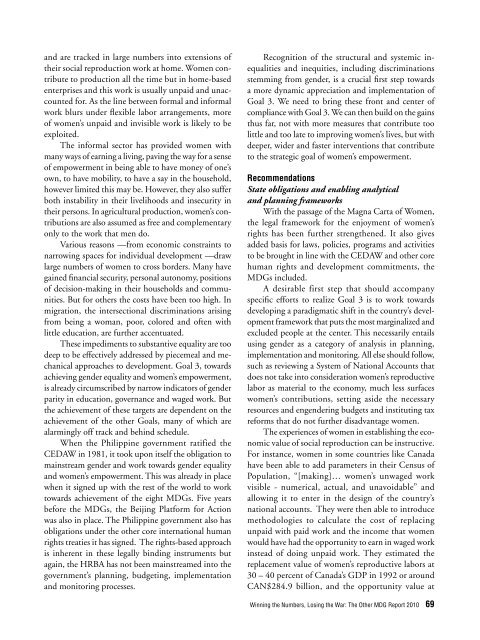Report - Social Watch Philippines
Report - Social Watch Philippines
Report - Social Watch Philippines
You also want an ePaper? Increase the reach of your titles
YUMPU automatically turns print PDFs into web optimized ePapers that Google loves.
and are tracked in large numbers into extensions of<br />
their social reproduction work at home. Women contribute<br />
to production all the time but in home-based<br />
enterprises and this work is usually unpaid and unaccounted<br />
for. As the line between formal and informal<br />
work blurs under fl exible labor arrangements, more<br />
of women’s unpaid and invisible work is likely to be<br />
exploited.<br />
The informal sector has provided women with<br />
many ways of earning a living, paving the way for a sense<br />
of empowerment in being able to have money of one’s<br />
own, to have mobility, to have a say in the household,<br />
however limited this may be. However, they also suffer<br />
both instability in their livelihoods and insecurity in<br />
their persons. In agricultural production, women’s contributions<br />
are also assumed as free and complementary<br />
only to the work that men do.<br />
Various reasons —from economic constraints to<br />
narrowing spaces for individual development —draw<br />
large numbers of women to cross borders. Many have<br />
gained fi nancial security, personal autonomy, positions<br />
of decision-making in their households and communities.<br />
But for others the costs have been too high. In<br />
migration, the intersectional discriminations arising<br />
from being a woman, poor, colored and often with<br />
little education, are further accentuated.<br />
These impediments to substantive equality are too<br />
deep to be effectively addressed by piecemeal and mechanical<br />
approaches to development. Goal 3, towards<br />
achieving gender equality and women’s empowerment,<br />
is already circumscribed by narrow indicators of gender<br />
parity in education, governance and waged work. But<br />
the achievement of these targets are dependent on the<br />
achievement of the other Goals, many of which are<br />
alarmingly off track and behind schedule.<br />
When the Philippine government ratified the<br />
CEDAW in 1981, it took upon itself the obligation to<br />
mainstream gender and work towards gender equality<br />
and women’s empowerment. This was already in place<br />
when it signed up with the rest of the world to work<br />
towards achievement of the eight MDGs. Five years<br />
before the MDGs, the Beijing Platform for Action<br />
was also in place. The Philippine government also has<br />
obligations under the other core international human<br />
rights treaties it has signed. The rights-based approach<br />
is inherent in these legally binding instruments but<br />
again, the HRBA has not been mainstreamed into the<br />
government’s planning, budgeting, implementation<br />
and monitoring processes.<br />
Recognition of the structural and systemic inequalities<br />
and inequities, including discriminations<br />
stemming from gender, is a crucial fi rst step towards<br />
a more dynamic appreciation and implementation of<br />
Goal 3. We need to bring these front and center of<br />
compliance with Goal 3. We can then build on the gains<br />
thus far, not with more measures that contribute too<br />
little and too late to improving women’s lives, but with<br />
deeper, wider and faster interventions that contribute<br />
to the strategic goal of women’s empowerment.<br />
Recommendations<br />
State obligations and enabling analytical<br />
and planning frameworks<br />
With the passage of the Magna Carta of Women,<br />
the legal framework for the enjoyment of women’s<br />
rights has been further strengthened. It also gives<br />
added basis for laws, policies, programs and activities<br />
to be brought in line with the CEDAW and other core<br />
human rights and development commitments, the<br />
MDGs included.<br />
A desirable first step that should accompany<br />
specifi c efforts to realize Goal 3 is to work towards<br />
developing a paradigmatic shift in the country’s development<br />
framework that puts the most marginalized and<br />
excluded people at the center. This necessarily entails<br />
using gender as a category of analysis in planning,<br />
implementation and monitoring. All else should follow,<br />
such as reviewing a System of National Accounts that<br />
does not take into consideration women’s reproductive<br />
labor as material to the economy, much less surfaces<br />
women’s contributions, setting aside the necessary<br />
resources and engendering budgets and instituting tax<br />
reforms that do not further disadvantage women.<br />
The experiences of women in establishing the economic<br />
value of social reproduction can be instructive.<br />
For instance, women in some countries like Canada<br />
have been able to add parameters in their Census of<br />
Population, “[making]… women’s unwaged work<br />
visible - numerical, actual, and unavoidable” and<br />
allowing it to enter in the design of the country’s<br />
national accounts. They were then able to introduce<br />
methodologies to calculate the cost of replacing<br />
unpaid with paid work and the income that women<br />
would have had the opportunity to earn in waged work<br />
instead of doing unpaid work. They estimated the<br />
replacement value of women’s reproductive labors at<br />
30 – 40 percent of Canada’s GDP in 1992 or around<br />
CAN$284.9 billion, and the opportunity value at<br />
Winning the Numbers, Losing the War: The Other MDG <strong>Report</strong> 2010 69


